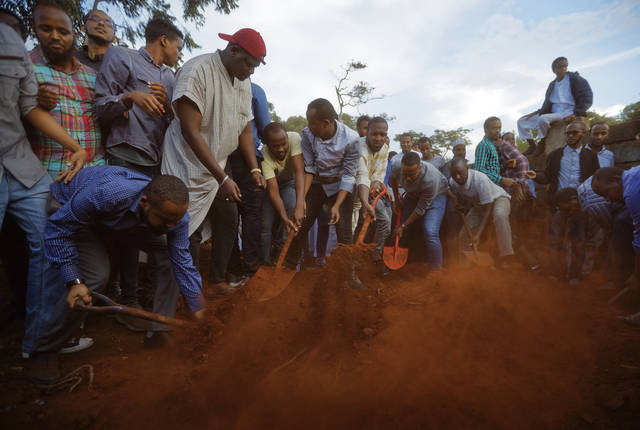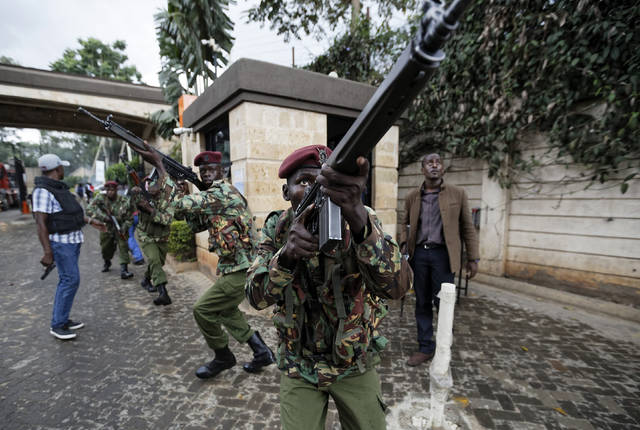NAIROBI, Kenya — Trapped in a Kenyan hotel under attack by extremists, June Chepkemei said she made peace with the fact that she might die.
Chepkemei, a communications specialist, was attending a workshop at the dusitD2 hotel in Nairobi on Tuesday when she heard a loud boom and gunfire. She told the Saturday Nation newspaper that she packed her laptop and fled upstairs, where she hid in a bathroom. Other colleagues hid behind curtains or under pillows on the bed. Security forces eventually broke down the door and led them to safety, ending hours of fear.
“I wrote to a close friend who I had contacted via text message and told her my final wishes,” Chepkemei said.
Days after the assault on the hotel complex in Kenya’s capital, stories of those who were there — victims and survivors, saviors and killers — have emerged, bringing depth to jarring images of civilians fleeing the chaos that were broadcast around the world. Authorities said 21 people, including a police officer, were killed by the attackers, all five of whom died.
There is a familiarity to what happened in Kenya, an East African economic power and popular tourist destination that has been a periodic target of bombings and other attacks for years. Once again it is mourning the dead, celebrating the brave and pursuing the perpetrators.
Al-Shabab, the al-Qaida-linked group that claimed responsibility, is based in neighboring Somalia and objects to Kenya sending troops to fight it. Analysts say Kenya’s crackdowns on its ethnic Somali minority have contributed to grievances. A son of a Kenya Defence Forces sergeant was identified in court documents as an attacker, while another — a 25-year-old suicide bomber — was born in the Kenyan coastal city of Mombasa.
Kenya will still face a “localized and grassroots” challenge from the extremists even if it withdraws troops from Somalia, where U.S. and African Union forces are fighting al-Shabab, said Ryan Cummings, director at Signal Risk, a risk management firm that focuses on Africa.
The extremists who attacked in Nairobi were recorded on security camera footage as young, menacing figures in dark clothing. Six people, including a Canadian national, have appeared in court for allegedly helping to organize the assault.
The paramilitary wing of the Kenyan police known as the General Service Unit led the security operation against the extremists that lasted some 20 hours. The unit has been generally praised, a reflection of training and reforms carried out after the government’s chaotic response to the attack at the nearby Westgate mall in 2013 in which at least 67 people died. That crisis took days to resolve.
Tuesday’s attack started at around 3 p.m. and Kenyan special forces had trapped four attackers on the seventh floor of a building by 3 a.m. on Wednesday, according to The Standard newspaper.
The newspaper said commandos had used a “robot” to locate the extremists through electronic signals and switched off power to the building to disable elevators. Although some attackers were believed to be communicating with people in Somalia, authorities decided not to jam phones for fear of alarming trapped civilians in touch with relatives, an unidentified official said.
According to the account, commandos decided at 4 a.m. to storm the room where the attackers were holed up rather than wait for daylight, which could have made it easier for the militants to target civilians. Security forces sprayed the room with high-caliber fire, killing the assailants in seconds. Two commandos suffered leg injuries from grenades thrown by the attackers, the newspaper said.
The attackers had announced their onslaught with explosions, including that of a suicide bomber identified as Mahir Khalid Riziki. He blew himself up outside the Secret Garden restaurant, recorded on security camera footage.
Witness Abdullahi Ogelo, who walked past Riziki just before the explosion, offered a rare glimpse into the agitated state of a man who was about to detonate explosives on his body. The man was speaking on the phone.
“Where are you guys?” the witness, interviewed by Kenyan media, recalled Riziki saying.
Police are investigating the possibility that the suicide bomber arrived separate from the other attackers and that his explosion was supposed to drive panicked people toward an area where the others could easily target them.
An early responder at the dusitD2 hotel complex was Inayat Kassam, a shooting instructor and security consultant who carried a handgun and escorted people to safety, just as he did in the Westgate attack. He was seen with blood on his shirt, possibly from a casualty, and has been praised as a hero in Kenyan media.
Some journalists, including photographer Dai Kurokawa of the European Pressphoto Agency, briefly stopped covering the siege and carried a man who was bleeding and unresponsive to an ambulance after a security official asked them for help.
“I just need four guys. Volunteer, please,” the official said, according to Kurokawa.
Families of the hundreds of people who were trapped, and of those who died, endured hours of uncertainty as the situation unfolded. Most victims were Kenyan; an American and a Briton also died.
Revenue manager Bernadette Konjalo, one of four dusitD2 employees who were killed, was known for her generosity, helping to pay school fees for some relatives.
Cousin Camillus Konjalo Adera described how her phone was switched off when he tried to reach her during the attack. He waited at the scene overnight then went to the morgue, he told the Daily Nation newspaper.
“We were in denial until we saw a birth mark,” he said.
———
Follow Christopher Torchia on Twitter at www.twitter.com/torchiachris




